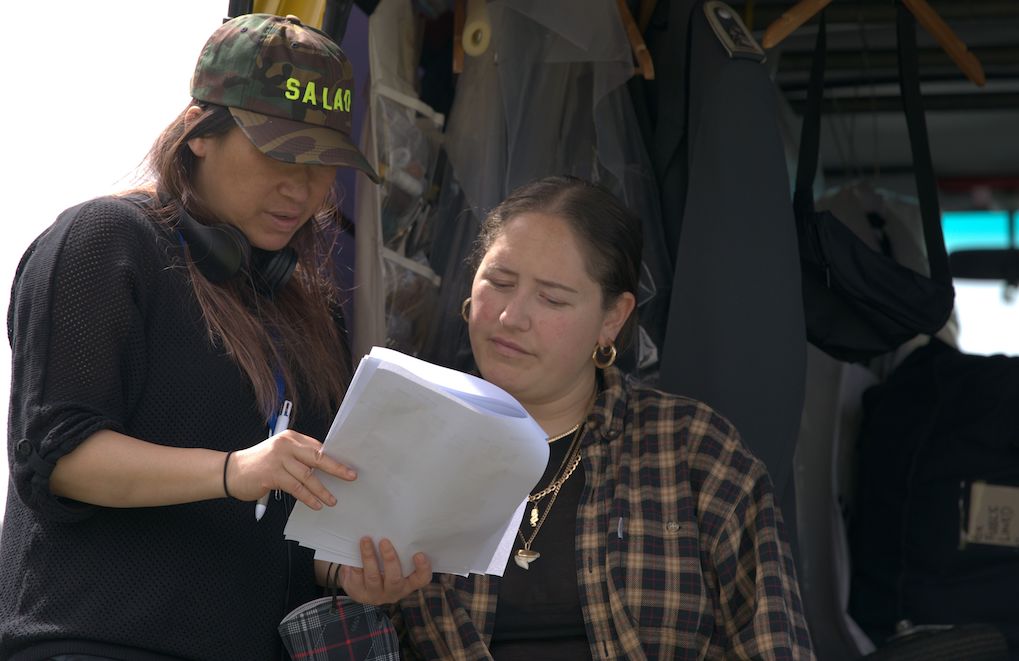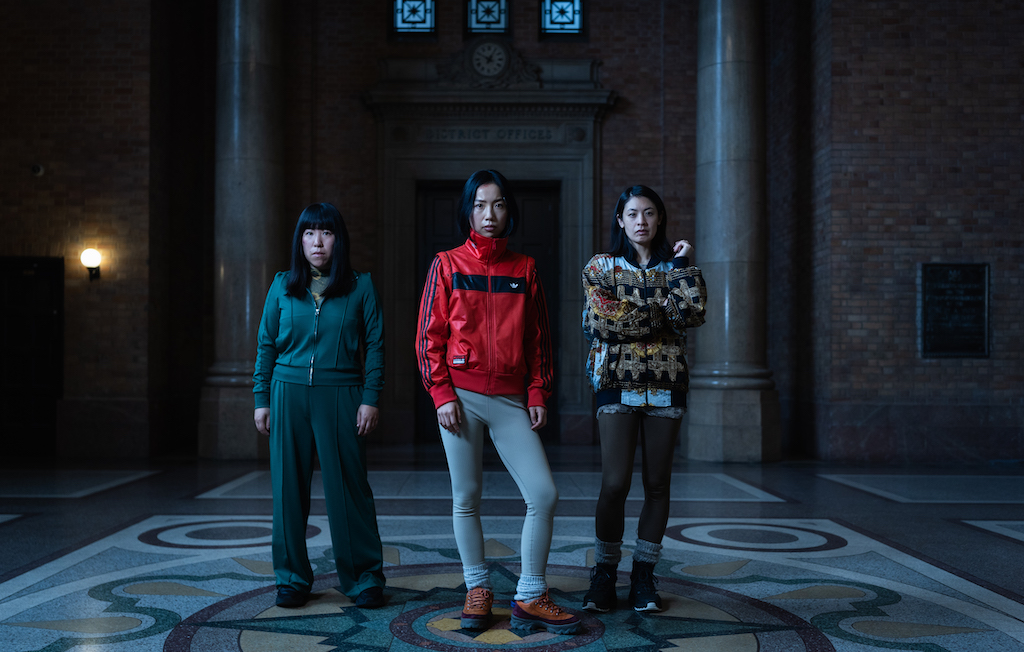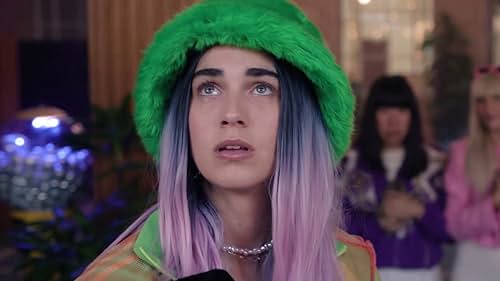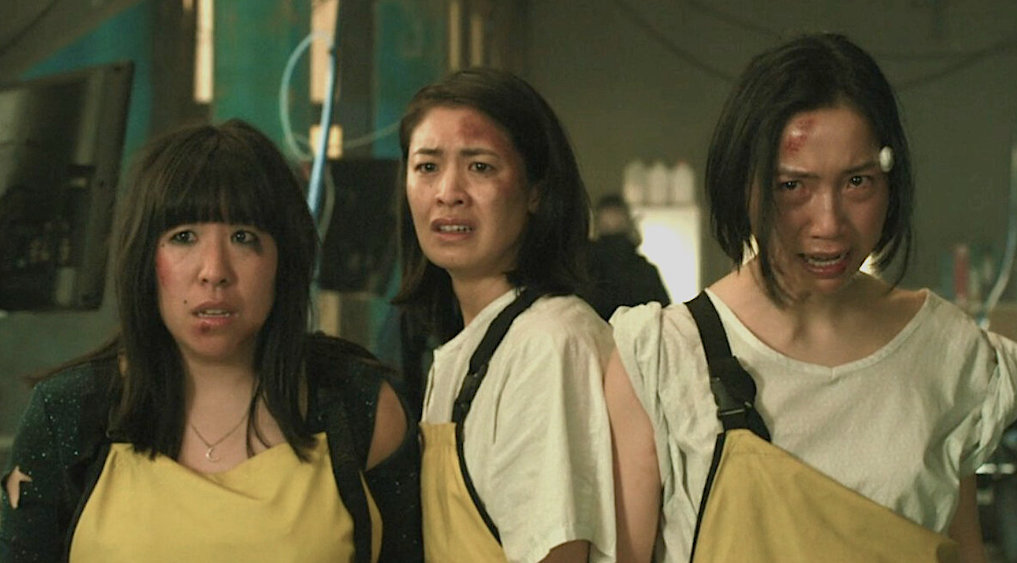
Creamerie is a show that pops off the screen. Its delightfully or tragically bonkers tone aside, it’s a show with exuberant style. The color did not suddenly vanish in the somewhat-post-apocalyptic world of Creamerie, which was created by Roseanne Liang, J.J. Fong, Perlina Lau, and Ally Xue.
With season two, costume designer Te Ura Taripo-Hoskins joined the crew of the series, based in New Zealand. The scope of the show expanded, showing more communities and, in one lovely example of a new addition, gave audiences a Gen Z Prime Minister of New Zealand. As a result, Taripo-Hoskins helped the show double down on its vision and deliver a variety of costumes that make the world of Creamerie a dark, scary world that’s not without a sense of fun.
Taripo-Hoskins has worked on projects such as Ahikaroa, Princess of Chaos, and Good Grief. Recently, the costume designer talked to Below the Line about her latest work on Creamerie and the benefits of trusting your gut.
Below the Line: What are you working on at the moment?
Te Ura Taripo-Hoskins: I’m working on a project called End of the Valley, which is a new Māori scripted drama, which is 70% bilingual to our language, which is pretty cool. It’s about two opposing tribes that lived side by side and are now battling with their treaty claims, their land claims, kind of stuff like that.
BTL: That sounds great.
Taripo-Hoskins: Pretty cool. One tribe is, they still live on their land, off the land, ride horses or in the bush, and the other tribe is the one that’s gone corporate, they’ve got lots of money, blah, blah, blah. Two conflicting tribes going head to head.
BTL: When you’re working on a show or in the office, as you are now, what days excite you the most as a costume designer?
Taripo-Hoskins: Definitely the days that I live for are the days where I am working to showcase our people on screen, and that 100% wasn’t Creamerie. That wasn’t an indigenous project, but if I can help in some way to bring our stories and our people and our language to light and showcase them in a way that isn’t the classic stereotype of Once We Were Warriors, I don’t know if you’ve seen that…
BTL: I haven’t, no.
Taripo-Hoskins: It’s a very iconic film that was made a long time ago, maybe even about 30 years ago. But there’s lots of family violence and stuff like that, which is of course a part of the culture, but it’s because of colonization, right? It’s a very small part, and there are so many other parts of us that I love to highlight and work with. I’ve kind of framed myself around being a Māori costume designer, which means that I get to make sure there’s cultural integrity and authenticity around how we look, which is not always there.
BTL: When did you realize as a costume designer that you didn’t only want to tell stories but also tell stories about your culture?
Taripo-Hoskins: I knew after I had worked on an MTV show called The Shannara Chronicles, and I was the buyer on that show, and I spent something which may not be huge in American budgets, but I think I spent $150,000 just in cash. Just in cash. And then not long after that, I worked on a small Māori drama show, and my entire budget was $10,000.
I thought, “Fuck, nobody is going to watch Shannara. Nobody is going to remember it in two years. It doesn’t really mean anything in the world, and it’s got all this money.” And then we are over here having our language on show, which is not common, and there’s no money for that. I was like, this is why I care more about this stuff.
In costume, it can be a very, what’s the word? It can be shallow, in a sense. We’re consuming, we are adding to consumerism. We’re buying what’s cool, and so much money going into things that don’t exactly help the world. So if we can find a way to make meaningful things and find some true meaning out of what we do, then that’s what makes me happier in everyday life.

BTL: When you’re working on a project, like Creamerie, what are some sustainable choices you want to make?
Taripo-Hoskins: Totally. With Creamerie, thankfully, a lot of it had to be sustainable just because of the storyline. They were out on the run, they were finding things off the side of the road in the back of a truck. They were coming to new communities or worlds where people just had what they had, and that’s what our lead characters ended up being in.
All of that had to naturally be old or be worn or feel like it belonged to someone else. It meant that a lot of outsourcing was secondhand there, which was great. You get so much more character, things are broken down for you already. That’s a big job taken off the list.
It’s definitely harder. As luck of the draw, you may or may not get what you’re looking for, but especially in where we are, where we don’t have heaps and heaps and heaps of goodwill stores or anything like that. So yeah, it makes it more fun, I think. More of a challenge.
BTL: Locally, where do you go to get clothes for productions?
Taripo-Hoskins: A lot of it is online these days just because there’s more variety. Otherwise, we are going to places like K Road, which is known for secondhand stores. It’s probably the higher end of our secondhand stores. It’s not the local Salvation Army where you drop anything off. And then we’ve got places like little secondhand boutiques scattered around the town. And then we’ve got big second hand stores called Savemart, where you can get a range of things of absolute crap or absolute amazing gems.
It’s going everywhere in the city. You’re going everywhere. We are picking a suburb or a part of the city to go to that day and we smash out those stores. South Auckland, West Auckland, Central Auckland, we do the rounds.

BTL: How’d you approach the Prime Minister of New Zealand? She’s fantastic.
Taripo-Hoskins: She was super cool. The idea of her is that Gen Z is taking over the world. Everyone that’s not Gen Z, they’re all kind of doing the labor jobs. I guess we really wanted to showcase the best version of how out there Gen Z could be.
Gen Z don’t necessarily have to identify with anything, and I feel more and more they aren’t identifying with anything that, say, I’m identifying with. They’re a lot more fluid in how they are. There’s less restrictions for them just in how they approach life.
BTL: How about the leads? Even though they are on the run this season, how’d you want to further define their style or presence in the series?
Taripo-Hoskins: Well, it was interesting because I didn’t design season one. They definitely had their own looks established, but I don’t think they were as, maybe not manicured, but they just weren’t as developed into the characters yet. So, my biggest thing was ensuring that they still felt like themselves from season one.
A big one, actually, was to gain the trust of these actors because we were a new costume team. And then also to make sure that what they were doing fit the new world of Creamerie of season two, and that we weren’t stuck in season one world, so that the characters were really rolling with where they ended up every time, but also had to be believable.
They were on the run. Where did they actually get the stuff from? When they end up at the sisterhood, they’re very much dressed in the sisterhood world, which is, everything was patched up. The scripts even said active wear and leather. So, a lot of that is already written into the scripts, which gives you an idea of what this new world’s going to be. And then you just run with your imagination off that.
But I generally find my first gut feeling or thought is where I run with things. From there, it just makes sense to me, first and foremost. And then I’m able to develop that initial thought or feeling with the directors, the actors, and my team.
BTL: That also must be great, having that part of your process where you’re so trustful of your gut.
Taripo-Hoskins: I think my team really appreciates it too. I’m quite decisive in what I want and I’m not leaving… I mean, sometimes I leave things for the last minute, but I always have a clear vision of what I want. I don’t know why, but I have that and I’m lucky. It’s made my job easier.

BTL: It seems like such a creatively harmonious show where everyone’s on the same page, but for your vision, are there days you have to go to the mat for ideas?
Taripo-Hoskins: Yeah. Do you want specific examples?
BTL: Yes, please.
Taripo-Hoskins: Well, there was one moment with the sisterhood [who lives in the bush], an actress, who was amazing, there was kind of black paint on her face. I just instinctively went, that doesn’t feel right to me, like we are doing something we shouldn’t. It feels maybe a bit Native American or going down the path of having a black face. She lives in the bush, she’s filthy, but does she need to be like that? And so, there were conversations with us in makeup and our director, Roseanne, about my initial instincts around that.
Let me tell you, the whole show, we shot it in five weeks. We maybe had four weeks of prep. Budgets are tight. It’s a big world that we are building, so we have to be realistic about what we actually can achieve in that time. I think day-to-day was a struggle for just every department. The schedule was a big one. A lot of the locations they were after weren’t locked in or they were falling through.
We weren’t really working off a schedule for a good three weeks. It was kind of day-by-day. If we weren’t ready, if we didn’t have the costumes made or they hadn’t arrived or whatever, I just had to be staunch in saying, “My department is not ready for this. We do not have these looks. We have to find this somewhere else because it’s not scheduled for three weeks and we’ve got to prep.” So yeah, that was a massive one. We were floating up in the air for a long time, and a lot of it was schedule, budget, it was huge.
BTL: Thanks for your honesty. When you’re on a schedule that fast, how do you cut corners without compromising? Obviously, it’s a part of the job, so is it something you’re comfortable with or just begrudgingly have to accept?
Taripo-Hoskins: It’s a bit of both. It really depends on what it is. I think there’s always a fight worth fighting if you deeply feel it in your gut. Sometimes that is with a director about what I think looks better than what they think. I mean, they hired me, right? Yeah, they hired me [Laughs].
Sometimes it is as simple as, I’m fighting for this look because I believe it’s a better look than what you think is. Or it’s, okay, fine. You know what? Fine, it was my second pick. If everyone’s happy with it, it’s okay. I can move on. It depends how many other issues there are, I think. If it’s going to be worth it, I’m going to fight for it.
Creamerie is now available to stream on Hulu.





